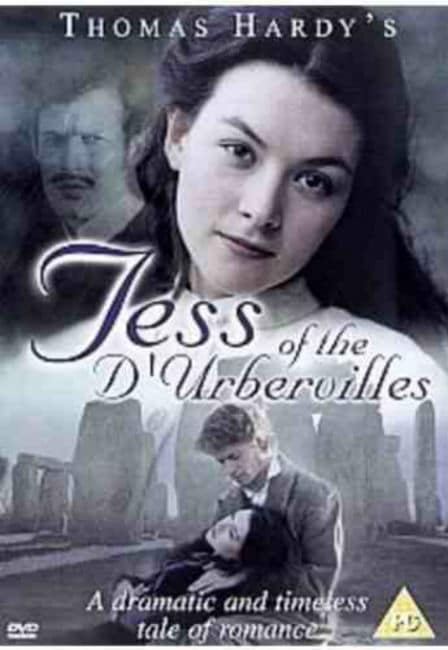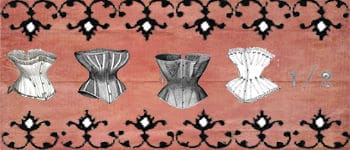Tess of the d’Urbervilles is Hardy’s best-known and most studied novel. Among other things, it challenged society’s treatment of women, especially those perceived to have fallen. Like many novels that criticise a society, it is a tragedy. This makes the film hard to watch at times, but it remains one of the best literary adaptations of Hardy’s work.
Tess at the May Dance
Tess is the eldest child of a poor country family. One day the parson of their small community mentions to her father that his family is descended from an old but extinct branch of the gentry. She is sent to claim kin with a well-to-do family that shares the name. Here she meets a distant cousin who pursues her mercilessly. After a terrible event befalls Tess, she returns home to her family. Eventually, Tess sets out again determined to seek out happiness and to escape her past. But it may not remain buried for long.

Alec and Tess
The performances are very strong. Justine Waddell makes a perfect Tess, bringing to life such a complex, tragic character with a great deal of sympathies and emotional depth. Jason Flemyng as Alec d’Urberville is appropriately sinister and strangely enjoyable to watch despite the nature of his character. Oliver Milburn plays the hypocritical Angel Clare with a deceptive charm. John McEnery and Lesley Dunlop are both very good as Tess’ short-sighted and deeply flawed parents.

Angel and Tess
The original score by Alan Lisk is extremely powerful and perfectly elevates the emotion of any given scene. I would compare it to the opening music in the 2004 adaptation of North and South in terms of emotional rawness. The look of the film is flawless with many beautiful scenes that appear almost to have been directly plucked from the pastoral paintings popular in the 1800’s. This is in part due to the costumes and use of the beautiful English countryside.

The lovers at StoneHenge
The production adapts the book quite closely taking advantage of its long running time. The character of Tess, while remaining very relatable, is at times frustrating in her determination to view herself as the sinner and to paint Angel as a good man incapable of wrongdoing. I hesitate to call either of Tess’ time with each suitor a romance given their individual unworthiness of her. They are both too shaped by the attitudes of the time though both men do show glimpses of what might have been if they had seen Tess as a human being instead of a prize or a womanly ideal.
Hardy often is criticised for being overly sentimental. You could certainly argue that this story is a bit extreme in getting its message across. Alternatively you could view it as a beautiful and tragic story of a free-spirited intelligent young woman treated badly by a hypocritical and cold society. Either way it is a good story that has lasted the test of time that never fails to garner sympathy for its misused heroine.
Out of the adaptations I’ve seen, this Tess is the best and truest adaptation. It is an enjoyable production that is beautifully executed with great acting and wonderful music. Some might find the bleakness to be rather off-putting. However, if you don’t mind the tragic aspect of the tale, Tess of the d’Urbervilles is a well told period drama, a good adaptation of a popular classic that is definitely well worth watching.
Photo Credits: London Weekend Television/ ITV/ A&E Television Networks
OVERALL RATING
“You had me at hello.”
ROMANCE RATING
“I have not the pleasure of
understanding you.”
More Period Drama.
More Vintage Reviews.
ARE YOU A ROMANCE FAN? FOLLOW THE SILVER PETTICOAT REVIEW:
 Our romance-themed entertainment site is on a mission to help you find the best period dramas, romance movies, TV shows, and books. Other topics include Jane Austen, Classic Hollywood, TV Couples, Fairy Tales, Romantic Living, Romanticism, and more. We’re damsels not in distress fighting for the all-new optimistic Romantic Revolution. Join us and subscribe. For more information, see our About, Old-Fashioned Romance 101, Modern Romanticism 101, and Romantic Living 101.
Our romance-themed entertainment site is on a mission to help you find the best period dramas, romance movies, TV shows, and books. Other topics include Jane Austen, Classic Hollywood, TV Couples, Fairy Tales, Romantic Living, Romanticism, and more. We’re damsels not in distress fighting for the all-new optimistic Romantic Revolution. Join us and subscribe. For more information, see our About, Old-Fashioned Romance 101, Modern Romanticism 101, and Romantic Living 101.





I have yet to see this version, but really want to. How does it compare to the 2008 version?
presentsofthepast.com
In my opinion, I prefer this version to the 2008 one. They both have great aspects to them, but I just connected to Justine Waddell’s performance as Tess more. I also really liked the atmosphere of this adaptation. So personally, I like both, but this one is definitely my favorite between the two. By the way, I love your blog! 🙂
Cool, good to know. I will have to set aside some time to watch this one. And thank you!
This version is also my favorite, although I did enjoy the 2008 Masterpiece Theatre miniseries and the 1979 feature film. The chemistry between Tess and Angel was very apparent, unlike the other two versions. Great acting, wonderful locations , costumes and music. In my opinion, Oliver Milburn was the best Angel, the most likeable (despite his hypocritical treatment of Tess); you really got the sense that he was remorseful and sincere when he returned to beg her forgiveness. You can see why Tess loves him; I didn’t get the same feeling in either Polanski’s film or in the BBC miniseries. Justine Waddell’s Tess is the only one that I took to right away, whereas Nastassja Kinski and Gemma Arterton grew on me. I think all three versions available have their own merits, and it would be interesting if the two silent film adaptations ever resurface (as of this writing, both are considered lost, as is a silent film of “Far From The Madding Crowd”), for comparison. since Hardy did live to see those adaptations.
The 2008 is my second favorite, but given the amount of time they had to establish the story and characters (four episodes) but it fell short . I couldn’t stand Eddie Redmayne’ s Angel and I actually thought Tess had more chemistry with Alec (I usually detest Alec, but Hans Matheson gave the character more depth) , but the ending was very moving and Arterton gave a very good performance. Jason Flemyng’s Alec was the more stereotypical seducer, and while Leigh Lawson gave a good performance in the 1979 movie, so many of the performances in that one were understated compared to the later television productions (both 1998 and 2008 adaptations had the benefit of filming in England, whereas the feature film had to be filmed in France) . A&E’s production will always have a special place in my heart, because it was the first that I saw and inspired me to read the novel, therefore introducing me to Thomas Hardy, and I think it deserves more attention than it gets. 🙂
Does anyone know where the may dance scene was filmed in the 1998 version? Minterne Magna perhaps?
Also, I do agree that this version is the best so far.